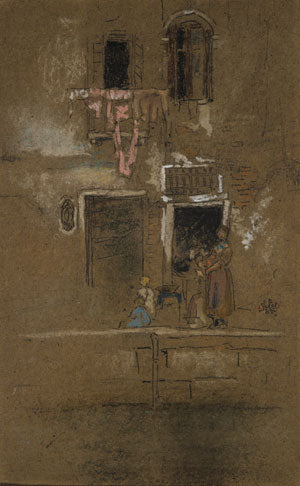Description
James McNeill Whistler, one of the most prominent artists of the nineteenth century, left an indelible imprint in art with his distinctive approach and his exceptional chromatic sensitivity. The work "Note in Pink and Brown" (1880) is a magnificent example of its mastery and its ability to transcend the artistic conventions of its time, producing a piece that captivates and challenges the viewer.
In "Note in Pink and Brown", Whistler presents an extremely minimalist composition, where the simplicity of the elements converges in an atmosphere of serenity and contemplation. The absence of recognizable characters and elements forces the viewer's eye to focus directly on the use of color and subtilely applied textures. This choice could be seen as a declaration of intentions by the artist, who deliberately departs from the explicit narrative to emphasize purity and emotion inherent in forms and colors.
The title of the work already suggests the predominant tones that we find in the painting: a harmonic game between pink and brown. Whistler uses these tones masterfully, creating a chromatic balance that feels ethereal and enigmatic at the same time. Rose, a color that usually evokes softness and delicacy, contrasts wonderfully with the terrible notes of the brown, conferring an almost palpable depth to paint. This subtle contrast could be interpreted as an exploration of the dualities and nuances of human experience, although Whistler prefers to leave these interpretations open to the viewer.
One of the most prominent aspects of Whistler's technique in this work is the apparent simplicity with which the pigment applies. The painting shows a smooth and homogeneous surface, with almost imperceptible brushstrokes that remember a technique close to the sfumato, where the colors melt delicately with each other. The texture is almost intangible, which brings an almost meditative quality to the work. It is not a canvas that demands attention immediately, but invites a leisurely and reflexive observation.
"Note in pink and brown" is inserted within the series of works that Whistler called "Night" and "Symphonies", where the titles refer more to musical compositions than to traditional visual narratives. This approach reveals Whistler's admiration for Japanese symbolism and art, disciplines that prioritize sensation and aestheticity about the literal representation of the observable world. Influenced by these currents, Whistler seeks to inspire a specific mood or emotional state in the viewer, leaving aside the anecdotal to favor the spiritual essence of the work of art.
In summary, "Note in Pink and Brown" is a testimony of James McNeill Whistler's ability to capture and express beauty in its purest and most abstract form. It is a work that challenges conventional visual expectations and that opens a silent dialogue between art and the spectator. The choice of colors, subtle technique and minimalist composition make this painting an intriguing and evocative piece, worthy of admiration and study. Through its still greatness, Whistler invites us to an aesthetic meditation that transcends the image itself, revealing the depth of the color and the shape in its most elementary and sublime state.
KUADROS ©, a famous paint on your wall.
Hand-made oil painting reproductions, with the quality of professional artists and the distinctive seal of KUADROS ©.
Art reproduction service with satisfaction guarantee. If you are not completely satisfied with the replica of your painting, we refund your money 100%.

